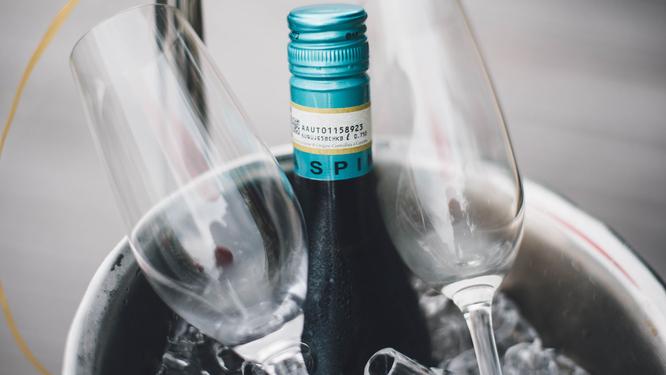If you're a casual wine drinker, there's a good chance you've been taught that white wines need to be chilled while red wines can be served at room temperature.
It's not entirely wrong, but wine pros tend to store their wine — red, white, rosé, sparkling, or still — in already chilled conditions, like cellars and specially designed wine fridges.
"I like to chill all of my wines," says Melissa L. Smith, sommelier and founder of Enotrias Elite Sommelier Services. "It tends to bring out the fruit flavors and minerality. Citrus is brighter, berries are heightened — the wines are more crisp and refreshing."
Ideally, chilling wine is done well in advance of when it's meant to be served. But when you're short on time or fridge space, it's possible to get room temperature wines down to their ideal drinking temperature quickly with a few simple, tried and true methods.
Smith notes that all wines can benefit from some refrigeration.
"Bright, young reds with low tannins like Pinot Noir and Gamay are fantastic with a bit of chill on them," says Smith. For older "library" wines and Cabernet Sauvignon, she recommends serving them just under room temperature, around 65 degrees Fahrenheit.
"For wines without oak — think most Sauvignon Blancs, Vinho Verde, Italian whites — I like to get them cold so that the flavors are bright," says Smith. "Sparkling wines are ideally served at closer to 45 degrees." Most still Chardonnay can be served around 55 degrees Fahrenheit, the typical temperature of a wine cellar.
If you don't have a wine cellar or wine fridge, it's possible to chill your bottle in the refrigerator, which takes at least two and a half hours for reds and three hours for whites. But when you're short on time, there are other ways to get your wine to the right temperature quickly.
The most intuitive way to chill a bottle of wine is putting it in the freezer. In a typical home freezer, a bottle of room temperature wine will take 30 to 40 minutes to cool to 50 degrees Fahrenheit.

Seeing that whites are served at a cooler temperature than reds, the freezer method is perfect for reds that only need to be brought down just below room temperature.
Smith notes that you should always set a timer to remind you to remove the bottle, as a forgotten bottle can freeze completely, or worse, explode.
In a deep container, dissolve half a pound of salt in room temperature water, then add plenty of ice. The salt helps to drop the temperature of the water from 32 degrees Fahrenheit to just 10 degrees Fahrenheit. Then, completely submerge the bottle for about 10 minutes. This is the most versatile method that works equally well for reds, whites, and rosés.
Smith also mentions the technique made famous by DLynn Procter in the movie "Somm," where the bottle is submerged in water with ice and then spun quickly, creating a convection effect.
To use this method, dissolve half a pound of salt in room temperature water, then add plenty of ice. Submerge the bottles and spin for 3 to 5 minutes. This increases the rate of transfer of heat exponentially, causing the liquid within the bottle to cool to serving temperature in less than 10 minutes.
This is particularly great for sparkling wines, like Champagne, that should be served at 45 degrees Fahrenheit — you'll get to your target temperature faster.
The thick glass of a wine bottle isn't great at thermal conduction, which means that it doesn't allow the cold air from your refrigerator to cool the wine inside very quickly.
Pouring the wine into a ziplock bag and submerging that bag into ice water can easily speed up the process to just a couple of minutes. This will work best with still white wine that needs to be brought to around 50 degrees Fahrenheit to 55 degrees Fahrenheit.
Alternatively, you can opt to pour still wine into glasses and chill them in the refrigerator, covered, in preparation to serve them — they will chill faster in individual serving sizes than they would in a full bottle. While you can do this with red, white, or rosé, this method doesn't work with sparkling wine, since the bubbles will fall flat if exposed to air for too long.
While this might make many wine connoisseurs cringe, adding a cube of ice to an inexpensive glass of Gruner Veltliner, Pinot Grigio, or rosé can be incredibly refreshing.
The only downside is that it might dilute the wine, and in turn, mute some aromas or flavors. You can opt to use frozen grapes or whiskey stones in place of ice cubes for a similar chilling effect without the risk of watering down your wine.
The serving temperature of wine can change how the wine is perceived on the palate, so getting it just right is important. If you aren't able to chill wine in advance, you can still cool a room temperature bottle in an hour or less with minimal effort.
For last-minute chilling, try placing the bottle in the freezer, submerging it in ice water, transferring it to a more thermal conductive container, or simply adding an ice cube to your glass.
Bernadette Machard de GramontAs the granddaughter of immigrant restaurant owners, Bernadette developed an interest in gastronomy at a young age, cooking everything from her family's Filipino and Chinese recipes to French classics. She also spent seven years in the wine industry helping clients purchase fine and rare wines to add to their collections. After 18 years of living in San Francisco, Bernadette headed south to Los Angeles, where she continues to write about food and culture, while sometimes working as a food stylist/photographer, product tester, and marketing consultant for the wine industry. Her work has appeared on Food52, The Spruce Eats, MyFitnessPal, Made Local, and Far & Wide.Read moreRead less